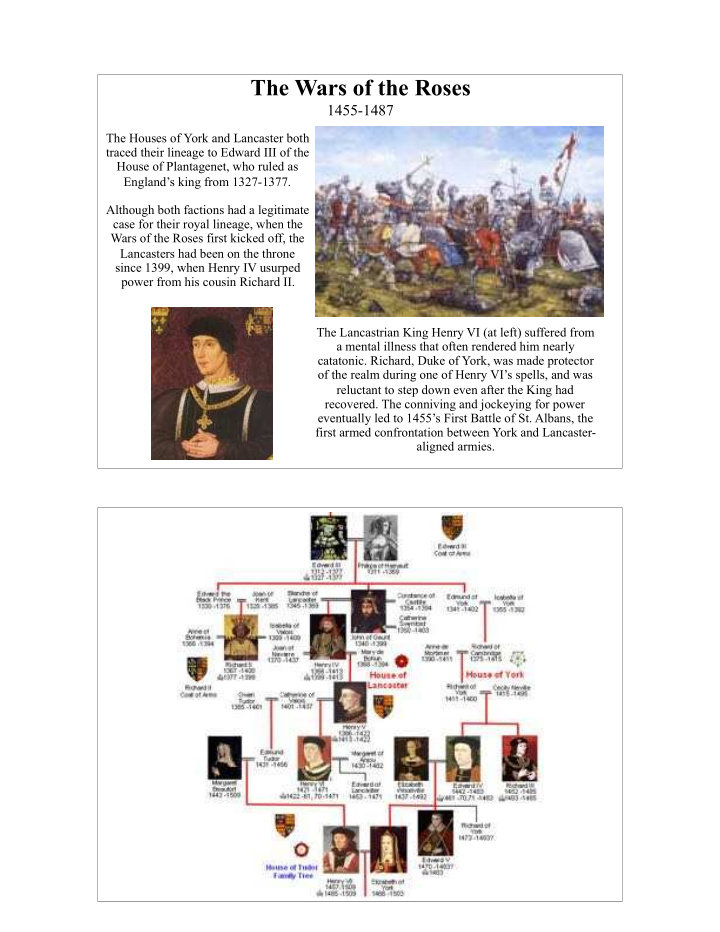



The Wars of the Roses 1455-1487 The Houses of York and Lancaster both traced their lineage to Edward III of the House of Plantagenet, who ruled as England’s king from 1327-1377. Although both factions had a legitimate case for their royal lineage, when the Wars of the Roses first kicked off, the Lancasters had been on the throne since 1399, when Henry IV usurped power from his cousin Richard II. The Lancastrian King Henry VI (at left) suffered from a mental illness that often rendered him nearly catatonic. Richard, Duke of York, was made protector of the realm during one of Henry VI’s spells, and was reluctant to step down even after the King had recovered. The conniving and jockeying for power eventually led to 1455’s First Battle of St. Albans, the first armed confrontation between York and Lancaster- aligned armies.
The House of York The House of Lancaster The White Rose of York The Red Rose of Lancaster Families in the North of England Henry VI’s descendants and who descended from the House their supporters were the of York were members of the Lancastrian faction. Yorkist faction, led by Richard, Duke of York, and his son The Lancaster faction Edward. was led by Queen Margaret of Anjou, the When Richard died in 1460, his wife of the King of son Edward became the leader of England, Henry VI. the York forces. Henry VI returned in Edward became King Edward IV 1470 with an army and in 1461 when Henry VI left the briefly regained the country for nine years following throne, but Edward IV a serious mental breakdown. raised a large army in the Netherlands and wrestled In 1464 Edward secretly married Elizabeth Woodville. The power away from marriage infuriated Richard Henry VI again, Neville, Earl of Warwick. In defeating the Yorkist alliance with Margaret of Anjou, forces and killing the Warwick forced Edward to flee Earl of Warwick. England. Princes in the Tower Edward IV ruled England without challenge from 1471 to his death in 1483. Upon Edward IV’s death, his brother Richard was named Lord Protector of the realm for Edward’s son and successor, the 12-year-old King Edward V. Before the young king could be crowned, however, his father’s marriage to his mother Elizabeth Woodville was declared invalid, making their children illegitimate and ineligible for the throne. Richard then declared himself King Richard III as the next Yorkist in line for the throne. However, while he had strong support in the northern regions of England, many southerners were outraged by the (presumed) murders of the young princes in the tower. Richard III then began his reign. The young princes were not seen in public again, and accusations circulated that the boys had been murdered on Richard's orders.
Battle of Bosworth Field 1485 The new leader of the Lancastrian forces, Henry Tudor, an obscure Welsh prince, led the house of Lancaster as it continued its warfare against Richard III. The Tudors had blood-ties to the House of Lancaster, and Henry Tudor had a strong claim to the throne (especially since most of the major Lancastrian and Yorkist candidates had killed each other during the previous thirty years of warfare!). The struggle ended at the Battle of Bosworth Field in 1485 when the Lancastrian faction won a decisive victory. Richard was slain during the battle by with a blow to the head from major Welsh landowner Rhys ap Thomas. The Yorkist army melted away after Richard was killed. King Richard III v. Henry Tudor The Tudor Dynasty Begins Henry Tudor declared himself King Henry VII, King of England. In the first few years of his reign, Henry VII eliminated all his rivals and married Edward IV's daughter Elizabeth to strengthen his descendant's claim to the throne. The marriage was a brilliant move politically; Elizabeth carried matrilineally the Yorkist claim to the throne, and Henry carried patrilineally the Lancastrian claim to the throne: Henry VII's children would have both Yorkist and Lancastrian blood. Their son became Henry VIII, and he in turn fathered Queen Elizabeth I, the illustrious monarch who ruled during Shakespeare's early career. The House of Tudor ruled England and Wales until 1603. The Tudor Rose combined the Red Rose of Lancaster and the White Rose of York.
Monarchs from the House of Tudor ruled England for 118 years from 1485 until 1603. Henry Tudor gained power and became Henry VII in the wake of the Wars of the Roses, was followed by his son, Henry VIII, (1509-47), famous for having six wives and bringing about the Reformation in England. Three of his children inherited the throne: Edward VI (1547-53), Mary I (1553-58), and Elizabeth I (1558-1603), who emerged as the greatest of her house. The Tudor dynasty became extinct on the death of Elizabeth without a direct heir in 1603. The crown of England then passed to Henry VII's great-grandson, James VI of Scotland, who became James I of England.
Recommend
More recommend